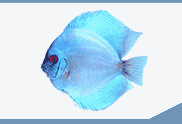

 |
||||||||||||
 |
||||||||||||
| Cryptobia iubilans in Cichlids | ||||||
| Ruth Francis Floyd and Roy Yanong | ||||||
What is Cryptobia? Cryptobia is a flagellated protozoan, closely related to Hexamita and Spironucleus, but not nearly as well understood. Like Hexamita and Spironucleus, Cryptobia is a very tiny (single-celled) organism, and consequently can be difficult to identify and study. There have been 52 species of Cryptobia identified in fish; however, because of its small size and difficult taxonomy, these may not all be separate species. Of the 52 species that have been identified, five are classified as ectoparasites that infect the gills and skin; seven are classified as enteric parasites that infect the gastrointestinal system; and 40 are classified as hemoflagellates which are found in the bloodstream. It has recently been proposed that the hemoflagellates be assigned to a subgenus called Trypanoplasma. The hemoflagellates have an indirect life cycle and are transmitted by leeches, whereas the gastrointestinal and ectoparasitic forms have direct life cycles. Cryptobia iubilans and Cichlids Cryptobia iubilans was first recognized in cichlids some 20 years ago. The organism is typically associated with granulomas (a tissue reaction) in the stomach, but systemic infections that involve the organism in blood and organ systems (including liver, gall bladder, kidney, ovary, brain, and eye) have been reported. It is not known how the organism is able to spread from the intestinal tract to other organs, or what causes the internal spread. Mortalities associated with the systemic form may exceed 50% of the infected population. The gastrointestinal form of Cryptobia has been reported in East African and Central American cichlids, including: Herichththys cyanoguttatum, Cichlasoma meeki, Cichlasoma nigrofasciatum, and Cichlasoma octofasciatum. Our laboratories have found it in some additional species, but most of the work has been done with Pseudotropheus zebra (Department of Fisheries and Aquatic Sciences, Gainesville, FL) and Symphysodon spp. (Tropical Aquaculture Laboratory, Ruskin, FL). In the summer of 1995, there was an outbreak of the systemic form of Cryptobia iubilans in cichlids at the Chicago Shedd Aquarium. The outbreak resulted in loss of 50% of the collection of East African cichlids including Cyphotilapia frontosa, Dimidiochromis compressiceps, and Aulonocara stuartgranti. The outbreak seemed to originate with the Aulanocara that had been purchased from a midwest wholesaler. While the fish were in quarantine, the infection spread to Herichthys meeki and H. nicaraguensis housed in the same tank. From there it spread to the C. frontosa and D. compressiceps that were housed in separate tanks but shared the same water due to a common filtration system. The sick fish went off feed for one to two days, becoming progressively more listless and withdrawing from contact with other fish. Just prior to death, they would move to the surface of the water and their respiration rate would increase dramatically, suggesting that they were hypoxic (suffering from low dissolved oxygen). Closer examination of fish at this stage of the disease revealed severe anemia, with packed cell volumes around 5% (normal should be greater than 30%). Death usually occurred within 24 hours of the development of severe anemia. Veterinarians at Shedd aquarium wanted to see how many species in their collection carried the parasite so they sacrificed 60 apparently healthy fish, and found evidence of Cryptobia iubilans in all but one (98% prevalence). These fish had granulomatous gastritis (the tissue reaction in the stomach) but no evidence of the systemic disease. The affected species included Haplochromis macula, Herichthys nicaraguensis, Labeotropheus fuelleborni, Herichthys aureus, Pseudotrpheus zebra and P. elongatus. Since the 1995 epizootic (disease outbreak), Shedd Aquarium has instituted a new quarantine protocol for all cichlids. All incoming cichlids are subjected to a minimum 60-day mandatory quarantine. A number of animals are screened for the presence of Cryptobia; any infected cichlid is culled. more ... |
 |
|||||
| About Us :: Message Board :: Chat | |||||
| Library :: Photo Gallery :: Links & Resources :: Breeders & Sponsors :: Merchandise | |||||
| Website designed by: EthanCote.com | © 2001-2004, SimplyDiscus.com. All Rights Reserved. | ||||